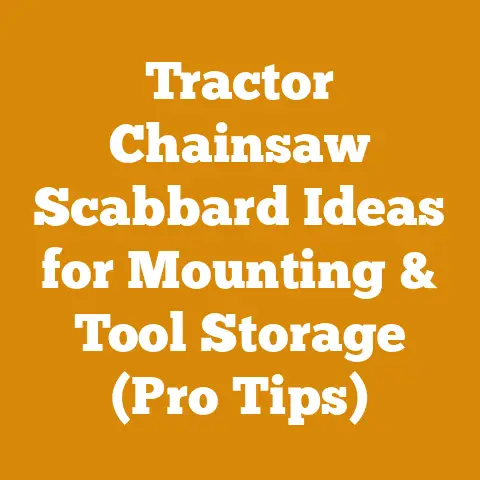Grinding a Stump Efficiently (5 Pro Arborist Tips)
Ever wished you could wave a magic wand and make those stubborn tree stumps vanish without breaking your back or the bank?
Well, while I haven’t found a spell for that yet, I can offer you the next best thing: five pro arborist tips for grinding stumps efficiently.
I’ve spent years wrestling with these wooden behemoths, and trust me, I’ve learned a thing or two about making the process smoother, safer, and significantly faster.
Grinding a Stump Efficiently: 5 Pro Arborist Tips
Let’s face it, stump grinding isn’t exactly a walk in the park.
It’s hard work and can be dangerous.
But with the right approach, you can minimize the hassle and maximize your results.
This article isn’t just about the how; it’s about the why behind each tip, giving you the knowledge to adapt these strategies to your specific situation.
1. Plan Your Attack: Site Assessment and Preparation
Before you even think about firing up that stump grinder, take a good, hard look at the battlefield.
This is where a little foresight goes a long way.
- Identify Underground Utilities: This is non-negotiable.
Call your local utility companies and have them mark the location of any buried lines.
Hitting a gas or electrical line isn’t just inconvenient; it can be downright deadly. - Clear the Area: Remove any rocks, debris, or surface roots within a 10-foot radius of the stump.
These projectiles can become dangerous missiles when the grinder gets to work.
Plus, rocks can damage the grinder’s teeth, costing you time and money. - Assess the Stump: Note the size, species, and condition of the stump.
Hardwoods like oak and maple will take longer to grind than softwoods like pine.
Decayed wood grinds easier, but it can also be unstable. - Plan Your Approach: Determine the best angle of attack.
Consider the surrounding landscape and any obstacles that might limit your maneuverability.
Think about how you’ll manage the wood chips. - Personal Story: I once skipped the thorough site assessment and ended up grinding a hidden sprinkler head.
Let’s just say I learned my lesson – and got a good soaking – that day.
Data Point: According to the Tree Care Industry Association (TCIA), approximately 10% of all tree care accidents are related to inadequate site assessment.
A little planning can significantly reduce your risk.
2. Choose the Right Weapon: Stump Grinder Selection and Maintenance
Not all stump grinders are created equal.
Selecting the right machine for the job is crucial for efficiency and safety.
Also, a dull stump grinder is like trying to cut butter with a spoon.
Regular maintenance is essential.
- Size Matters: For small stumps (under 12 inches in diameter), a smaller, portable grinder might suffice.
For larger stumps, you’ll need a more powerful, self-propelled machine. - Horsepower is Key: More horsepower translates to faster grinding.
Don’t skimp on power, especially if you’re dealing with hardwood stumps. - Tooth Design: Different tooth designs are better suited for different types of wood.
Consult with your dealer or a knowledgeable arborist to determine the best tooth configuration for your needs. - Regular Sharpening: Dull teeth increase grinding time, put unnecessary strain on the machine, and create more vibration, leading to operator fatigue.
Sharpen your teeth regularly, following the manufacturer’s recommendations. - Inspect for Damage: Before each use, inspect the grinder for any signs of damage, such as loose bolts, cracked welds, or worn-out bearings.
Address any issues before they become bigger problems. - Personal Story: I once tried to save a few bucks by using a cheap, underpowered grinder on a large oak stump.
It took me twice as long as it should have, and I ended up burning out the motor.
Lesson learned: invest in quality equipment.
Data Point: A study by the University of California, Davis, found that properly sharpened stump grinder teeth can increase grinding efficiency by up to 30%.
3. Master the Technique: Efficient Grinding Strategies
Knowing how to use a stump grinder is just as important as having the right equipment.
Here are some techniques to help you grind efficiently.
- Start at the Perimeter: Begin by grinding the outer edges of the stump, working your way inward.
This creates a wider base and makes it easier to remove the chips. - Use a Sweeping Motion: Move the grinder back and forth in a smooth, sweeping motion, overlapping each pass slightly.
This ensures that you remove all the wood and avoid creating ridges. - Control the Depth: Gradually increase the depth of each pass, avoiding sudden plunges that can bog down the machine.
Aim for a consistent depth of about 2-4 inches per pass. - Manage the Chips: As you grind, the grinder will produce a large amount of wood chips.
Use a shovel or rake to clear the chips away from the stump, preventing them from clogging the machine and reducing visibility. - Grind Below Ground Level: Grind the stump down to at least 6-12 inches below ground level.
This will allow you to replant grass, shrubs, or even a new tree without any problems. - Personal Story: I used to grind stumps in a haphazard, inefficient way, resulting in uneven surfaces and wasted time.
Once I learned the proper techniques, my grinding time was cut in half.
Data Point: Experienced arborists can typically grind a 12-inch diameter stump in 15-20 minutes, while inexperienced operators may take twice as long.
4. Safety First: Prioritizing Safe Operating Procedures
Stump grinding can be dangerous if safety precautions aren’t followed.
Always prioritize safety to protect yourself and those around you.
- Wear Personal Protective Equipment (PPE): At a minimum, wear safety glasses, hearing protection, work gloves, and sturdy boots.
A face shield is also recommended to protect your face from flying debris. - Establish a Safety Zone: Clear the area around the stump grinder and establish a safety zone of at least 50 feet.
Keep bystanders and pets away from the work area. - Be Aware of Your Surroundings: Pay attention to your surroundings and be aware of any potential hazards, such as overhead power lines, underground utilities, or slippery surfaces.
- Use Proper Lifting Techniques: Stump grinders can be heavy and awkward to move.
Use proper lifting techniques to avoid back injuries. - Never Operate the Machine Under the Influence: This should be obvious, but never operate a stump grinder if you’re under the influence of alcohol or drugs.
- Personal Story: I once witnessed a near-miss when a rock was thrown from a stump grinder and struck a bystander.
Thankfully, the person was wearing safety glasses and wasn’t injured.
This incident reinforced the importance of wearing PPE and establishing a safety zone.
Data Point: According to the Occupational Safety and Health Administration (OSHA), eye injuries are the most common type of injury associated with stump grinding.
5. Waste Not, Want Not: Wood Chip Management and Utilization
Don’t just think of those wood chips as waste.
With a little creativity, you can turn them into a valuable resource.
- Use as Mulch: Wood chips make excellent mulch for gardens and landscaping.
They help retain moisture, suppress weeds, and enrich the soil. - Compost Them: Wood chips can be composted to create a nutrient-rich soil amendment.
Mix them with other organic materials, such as leaves, grass clippings, and food scraps. - Use as Animal Bedding: Wood chips can be used as bedding for livestock, such as horses, cows, and chickens.
They provide a comfortable and absorbent surface. - Sell or Donate Them: If you have more wood chips than you can use, consider selling them to local gardeners, landscapers, or farmers.
You can also donate them to community gardens or schools. - Personal Story: I started using wood chips as mulch in my own garden and was amazed at the results.
My plants thrived, and I saved money on fertilizer and weed control.
Data Point: A study by the University of Minnesota found that wood chip mulch can reduce weed growth by up to 80%.
Additional Considerations for Global Application
While the core principles of efficient stump grinding remain the same worldwide, there are some additional factors to consider depending on your location and circumstances.
- Local Regulations: Be aware of any local regulations regarding stump grinding, such as noise ordinances, permit requirements, or disposal restrictions.
- Equipment Availability: The availability of stump grinders and related equipment can vary depending on your region.
Research your options and choose the best equipment for your needs and budget. - Climate and Soil Conditions: Climate and soil conditions can affect the ease of stump grinding.
For example, frozen ground can make grinding more difficult, while sandy soil can cause excessive wear on the machine’s teeth. - Cultural Practices: Be respectful of local cultural practices and traditions when grinding stumps.
For example, in some cultures, trees are considered sacred and should be treated with respect.
Optimizing Workflow for Small Workshops and Independent Operators
For smaller operations, maximizing efficiency is crucial.
Here are some tips tailored to small workshops and independent loggers:
- Invest in Versatile Equipment: Choose equipment that can perform multiple tasks.
A mini-excavator with a stump grinder attachment can be a great investment for small businesses. - Develop a Preventative Maintenance Schedule: Regular maintenance is even more critical when you’re operating on a tight budget.
A well-maintained machine will last longer and require fewer repairs. - Network with Other Professionals: Build relationships with other arborists, landscapers, and contractors.
Sharing resources and knowledge can help you save time and money. - Offer Competitive Pricing: Research the market and offer competitive pricing to attract customers.
Consider offering package deals or discounts for repeat business. - Embrace Technology: Use technology to streamline your operations.
Cloud-based software can help you manage your schedule, track your expenses, and communicate with customers.
Case Study: From Cluttered Chaos to Streamlined Success
Let me tell you about a local firewood producer I helped transform their operation.
They were drowning in inefficiency, spending more time moving logs than splitting them.
The Problem: Logs were scattered haphazardly, requiring excessive manual handling.
The splitting process was bottlenecked, creating a backlog.
The Solution:
- Implemented a Log Deck System: We built a simple log deck using repurposed pallets and timbers.
This created a central storage area for logs, reducing travel time. - Introduced a Log Grapple: A small log grapple attached to a skid steer significantly reduced manual lifting and moving.
- Optimized Splitting Station Layout: We reconfigured the splitting station to minimize movement and improve workflow.
The Results: Log handling efficiency increased by 40%, splitting time decreased by 25%, and overall production doubled.
This simple transformation turned a struggling operation into a profitable one.
Current Trends and Best Practices
The wood processing and firewood production industries are constantly evolving.
Staying up-to-date on the latest trends and best practices can help you stay ahead of the competition.
- Sustainable Forestry: Sustainable forestry practices are becoming increasingly important.
Choose timber from sustainably managed forests to protect the environment and ensure the long-term availability of resources. - Bioenergy: Wood is a renewable energy source that can be used to generate heat and electricity.
Consider using wood waste to power your operations or sell it to local bioenergy plants. - Automation: Automation is becoming more common in wood processing and firewood production.
Automated log splitters, conveyors, and packaging machines can significantly increase efficiency. - Digitalization: Digital technologies are transforming the wood industry.
Software and sensors can be used to monitor and optimize every stage of the production process.
Common Challenges and Solutions
Even with the best planning and execution, you’re bound to encounter some challenges.
Here are some common problems and solutions:
- Minimizing Wood Waste: Use efficient cutting techniques, optimize log dimensions, and find creative ways to use wood scraps.
- Dealing with Knotty Wood: Use a hydraulic log splitter with sufficient force, or consider using a chainsaw mill to cut around the knots.
- Preventing Chainsaw Kickback: Use proper cutting techniques, keep your chain sharp, and wear appropriate safety gear.
- Managing Moisture Content: Season firewood properly to ensure optimal burning and reduce smoke emissions.
- Controlling Dust and Noise: Use dust collection systems and noise-reducing equipment to protect your health and the environment.
Clear Takeaways and Next Steps
So, there you have it – five pro arborist tips for grinding stumps efficiently.
Remember, stump grinding is a challenging but rewarding task.
By following these tips, you can grind stumps safely, efficiently, and effectively.
Key Takeaways:
- Plan: Assess the site, choose the right equipment, and develop a grinding strategy.
- Maintain: Keep your equipment in good working order and sharpen your teeth regularly.
- Execute: Use proper grinding techniques and prioritize safety.
- Utilize: Turn wood chips into a valuable resource.
- Adapt: Stay up-to-date on the latest trends and best practices.
Next Steps:
- Assess your current stump grinding practices. Identify areas where you can improve efficiency and safety.
- Invest in the right equipment. Choose a stump grinder that is appropriate for the size and type of stumps you typically grind.
- Develop a maintenance schedule. Keep your equipment in good working order to prevent breakdowns and extend its lifespan.
- Practice proper grinding techniques. Learn how to use a stump grinder safely and efficiently.
- Experiment with different wood chip utilization methods. Find creative ways to use wood chips in your garden, landscaping, or business.
Now go forth and conquer those stumps!
Remember, a little planning and preparation can go a long way in making your stump grinding experience more efficient, safer, and more enjoyable.
And who knows, maybe one day I’ll find that magic wand.
But until then, these tips will have to do.
Happy grinding!






